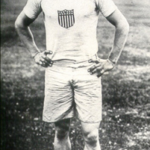Fascinating Olympics Facts
 Why Do Olympians Wear Colored Tape?
Why Do Olympians Wear Colored Tape?
The colored tape the Olympians and other athletes wear is called “Kinesio® Tex Tape”, which is essentially just an elastic cotton strip with an acrylic, heat activated adhesive. The tape was designed in the 1970s by a Japanese chiropractic and acupuncture specialist, Kenzo Kase. To date, there hasn’t been a single reputable study that conclusively shows this tape actually does anything the makers and athletes claim it does, though as Kevin Anderson, director of Kinesio UK, states “There’s a lot more needed on the research side to confirm the positive results we’re seeing so far.” (In truth, there have been numerous studies in the over 30 years this tape has been around and so far the results of using the tape have been more or less in-line with the placebo effect. It’s interesting that the… (more)
When Baron Pierre de Coubertin founded the International Olympic Committee (IOC) in 1894, he declared that one of the missions of the modern Olympiad would be “to reunite in the bonds of legitimate wedlock a long-divorced couple — Muscle and Mind.” To the Baron, Olympic competition wasn’t just going to be about physical athletics, but sports of the mind as well – and there are fewer greater “sports of the mind” than the arts. From 1912 to 1948, in seven Olympiads, over 151 Olympic medals were awarded in artistic competitions. Growing up in the French autocracy, Coubertin valued a classical education. He loved sports, especially rugby, but there is little evidence he was particularly… (more)
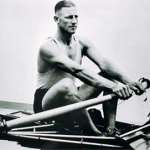 That Time an Olympic Rower Stopped to Let Some Ducks Swim By and Still Won the Gold Medal
That Time an Olympic Rower Stopped to Let Some Ducks Swim By and Still Won the Gold Medal
Born in Sydney Australia in 1905, Henry Robert Pearce, better known as Bobby Pearce, dominated the world of competitive rowing throughout the 1920s and 1930s and was extremely popular with fans of the sport due to a combination of the ease with which he seemed to best opponents and his affable personality. Perhaps the greatest example of both of these things in action was the time Pearce stopped mid-race to allow a duck and her ducklings to pass in front of him and still won. This particular anecdote from Pearce’s life occurred at the 1928 Summer Olympics in Amsterdam during the quarter final of the single sculls event in the Sloten canal. For anyone unfamiliar, the single sculls is essentially… (more)
 The Trials and Tribulations of 1904 Olympic Marathon Runners
The Trials and Tribulations of 1904 Olympic Marathon Runners
When the United States hosted the Olympics for the first time in 1904, the games had yet to reach the high level of competition and popularity we know today. Although athletes from countries around the world were invited to participate, the games were less about the world’s best athletes competing for medals and more about (actual) amateur athletes competing against each other. The ultimate decision to host the 1904 Olympic Games in St. Louis, Missouri, created a huge obstacle for international athletes in that travel to the innermost parts of the States was difficult and costly. The only way to travel between continents was by a long and expensive ocean voyage, after which the athletes needed to take about a 1,000-mile train trip. As a result, many countries decided not to participate. Out of the 630 athletes from 12 nations that competed that year, 523 were American, which explains why the United States won so many medals that year (239, with the closest runner up being Germany who won 13). Perhaps one of the most surprising athletes to compete for his country was Félix de la Caridad Carvajal y Soto… (more)
 How Much are Olympic Gold Medals Worth?
How Much are Olympic Gold Medals Worth?
As far as the value of the raw materials in them, this varies from Olympiad to Olympiad. For the recent 2012 Olympics in London, the medals were the largest of any in Summer Olympic history up to that point, weighing in at 400g for the gold medal. Of this 400g, 394g was sterling silver (364.45g silver / 29.55g copper) with 6g of 24 karat gold plating. At the price of gold and silver when these medals were won by various Olympians, this means a gold medal in the London Olympics was worth about $624, with $304 of the value coming from the gold plating and about $320 coming from the sterling silver. Since then, the price of gold has dropped about 18% and the price of silver has dropped about 39%. For the current 2016 Rio Olympics… (more)
 Do Olympic Medalists Receive Cash Prizes With Their Medals?
Do Olympic Medalists Receive Cash Prizes With Their Medals?
Some are awarded cash prizes by their respective local Olympic committees or governments. Also, sometimes private businessmen will match values given, such as in Armenia where a man donated $700,000 to be added to the cash given by the Olympic committee for medals. Another similar thing occurred for Belarus athletes during the 2008 Beijing Olympics. Those Belarusians who won any medal in the Olympics that year not only got a cash prize ($100,000 for gold, $50,000 for silver, and $30,000 for bronze), but also were given free meat and sausage for life from a local major meat company, Belatmeat. In the end, though, typically any cash prizes and the decision on whether to award them each Olympics is decided by the local Olympic Committees in each country and generally all the cash for the bonuses comes from these committees. As to the amounts of these prizes, the United States Olympic Committee awards… (more)
Bonus Olympic Facts:
- At the 1904 Summer Olympics, American gymnast George Eyser fared quite well- he won six medals: 3 gold in long horse vault, 25 ft. rope climb, and parallel bars; two silver in the 4-event all-around and pommel horse, and one bronze medal in the horizontal bar. While winning six medals in the Olympics is quite an accomplishment for anyone, what makes Eyser even more unique is that he competed with a wooden leg. During his youth, Eyser lost most of his left leg after a train ran over it. This, however, didn’t stop him from making history a few years later, becoming the only person to compete in the Olympic Games with an artificial leg, until 2008 when South African swimmer, Natalie du Toit, competed in the Beijing Olympics.
- During the 1988 Seoul Olympics, when the Olympic flame was lit, they accidentally burned alive some of the doves that were released as a part of the ceremony… If you care to see this, there is footage of it on YouTube.
- The third day of the ancient Olympic Games began with a sacrifice to Zeus, which was the highlight of the Games. A herd of 100 bulls were slaughtered by a team of priests after a procession to the Great Altar of Zeus. The thighs of the dead bulls were burned as a sacrifice, while the remains of the bulls were used in the victory banquet at the end of the games.
- In the 1500s most Roman Catholic countries & Scotland adopted the Gregorian Calendar (established by Pope Gregory XIII to compensate for the errors in time that had built up over centuries) over the Julian Calendar (introduced by Julius Caesar in 45 BC) . A lot of protestant countries however, ignored this new calendar for another 200 or so years. England stuck to the Julian Calendar until 1751 before finally making the switch. Orthodox countries took even longer to accept the change in calendars. Russia, for one did not convert to the Gregorian calendar until after the Russian Revolution in 1917. What does this have to do with the Olympics? The funny thing was, in 1908, the Russian Olympic team arrived 12 days late to the London Olympics because of it.
- In the 1936 Olympics in Berlin, the person who finished in fourth place in the women’s high jump was actually a man, German athlete Heinrich Ratjen. Two years later, he won a gold medal setting a new “women’s” world record in high jump at the European Athletics Championships, before his real gender was discovered randomly when police got a report that there was a man dressed as a woman traveling in Magdeburg.
- While Geena Davis is perhaps best known for her acting work, in roles such as Thelma & Louise, Beetle Juice, a League of Their Own, The Accidental Tourist, and the TV series Commander in Chief (winning an Academy Award and a Golden Globe along the way), what’s less well known is that she is a member of Mensa (top 2% in intelligence by IQ), is fluent in Swedish (after spending time as an exchange student in Sandviken in High School), and began her career in the spotlight as a window mannequin for Ann Taylor, directly after she graduated from college. Further, in 1997, she decided to take up a new hobby- archery. A mere two years later, she finished 24th out of 300 semifinalists who tried out for the 2000 Olympic games in Australia, narrowly missing the U.S. Olympic team.
- Tug of war was an Olympic event until after the 1920 Olympics. Multiple teams from countries were allowed, which is how the U.S. won bronze, silver, and gold in 1904. Britain did the same thing in 1908.
 Why Do Olympians Bite Their Medals?
Why Do Olympians Bite Their Medals?
According to four time Olympic medalist Summer Sanders, mainly because the photographers incessantly ask them to until they do it, usually at the end of the podium photo shoot sessions. The tradition probably stems from the age old practice of testing whether something was really solid gold or not by biting it. Gold is a very soft metal, at least softer than tooth enamel, and if it’s fairly pure, you should be able to leave some teeth marks in it by biting it. The practice of biting precious metals also allowed people to see if perhaps the gold object was really just gold plated, with something like lead at the center. If so, the gold plating could be scraped off with your teeth and, given the often bitten gold coins weren’t that thick, the plating tended to be fairly thin… (more)
 Late for the Olympics: The Amazing Story of Kipchoge Keino
Late for the Olympics: The Amazing Story of Kipchoge Keino
Kipchoge Keino, aka Hezekiah Kipchoge Keino or (thankfully in the interest of avoiding typos) just Kip, is a retired athlete who ran for the country of Kenya. Throughout his career, Kip earned almost a dozen medals, half of which were gold, for being an amazing middle to long distance runner. The story we want to share is the time Kip was almost late for his own race and had to (literally) run to get there, then won a gold medal anyway, despite another major adversity in that race, which we’ll get to in a minute. First, a little info on the man himself, because he’s awesome. We’ll start with his name… (more)
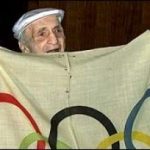 That Time the Olympic Flag Went Missing for 77 Years and Turned Up in a Suitcase
That Time the Olympic Flag Went Missing for 77 Years and Turned Up in a Suitcase
The year was 1920. The Summer Olympics were being held in Belgium in the city of Antwerp. At the end of the Olympic Games, the flag suddenly went missing. Fast-forward to 1997 and 101 year old bronze medalist Hal Haig Prieste, who won his medal in 1920 for platform diving, was being interviewed at a U.S. Olympic Committee dinner. During the interview, the reporter happened to mention the missing flag to Prieste, who then shocked everyone by stating… (more)
 The Olympic Swimmer Who Had Never Been in a Pool Until a Few Months Before Competing in the Olympics
The Olympic Swimmer Who Had Never Been in a Pool Until a Few Months Before Competing in the Olympics
The man was Eric Moussambani Malonga, later nicknamed “Eric the Eel”. Moussambani is from Equatorial Guinea in Africa and only managed to get into the Olympics at all because of a wildcard drawing system put in place by the International Olympic Committee, designed to try to encourage developing countries to participate in various Olympic events. Thanks to this drawing, Equatorial Guinea decided to send a swim team to the 2000 Olympics in Sydney, Australia. They put out an advertisement on the radio a few months before the Games to try to get people to come and tryout for the country’s new national swim team which would be going to the Olympics. Those who wished to tryout were to show up at the Hotel Ureca in Malabo, Equatorial Guinea. At the time… (more)
 Why No One Would Dare Do the Official Olympic Salute Anymore
Why No One Would Dare Do the Official Olympic Salute Anymore
In this Olympic salute, your right arm should be held out, slightly to the side, and pointing in an upward angle. Likewise, your palm should be out and your fingers touching. The Nazi salute is more or less performed the same way, except it is customary to hold your arm straight in front of you, instead of partially to the side. As you might imagine, the Olympic salute fell out of favor after WWII. Despite this, the International Olympic Committee hasn’t yet replaced it with a different salute, even if nobody would dare use it anymore for fear of being misinterpreted. The similarity of the salutes ultimately led to a great deal of confusion during the 1936 Olympics in Berlin… (more)
When people make lists of the greatest athletes of the 20th century, they are populated with the usual suspects: Michael Jordan, Babe Ruth, Muhammad Ali, Serena Williams, Wayne Gretzky, Jim Brown, Pele… but there is one name that should always make the list even though many people, even the biggest sports fans, may not recognize it, or if they do, they know little about the man- Jim Thorpe. The story of Jim Thorpe is one of determination, triumph, tragedy, racial prejudice, controversy, and extraordinary athletic achievement. Born approximately May 28, 1887 (the exact date has been disputed) in a small one-room cabin near the town of Prague, Oklahoma, Jim was the son of a farmer named Hiram and a Potawatomie Indian named… (more)
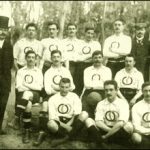 The Origin of the Olympic Rings
The Origin of the Olympic Rings
The Olympic ring symbol was designed by Baron Pierre de Coubertin in 1912. The idea of using rings intertwined with one another came from the Union des Sociétés Françaises de Sports Athlétiques (USFSA), which had two interlaced rings as their symbol and which Pierre de Coubertin was for a time the head of. It was founded by two French sports associations that merged, hence the two interlinked rings. As far as the colors, this was also from the USFSA’s logo design. Teams within the organization would wear white shirts with the interlinked rings being red and blue… (more)
 From Track Scrub to Olympic Record Setter- Fosbury and His Flop
From Track Scrub to Olympic Record Setter- Fosbury and His Flop
In the early 1960s, high school athlete Dick Fosbury probably never imagined that he would set the Olympic high jump record in 1968. The then teenager at Medford High School in Oregon participated in the high jump portion of track and field, but as a sophomore, he failed to clear the 1.5 meter height required to qualify for a number of high school track meets. The standard high jump techniques of the day included such techniques as the straddle and the upright scissors method. In the former, the jumper takes off from the inner foot to pass over the bar with their face down and legs straddling it. While American high jumpers at the Olympics used the technique to earn… (more)
 Origin of the Olympic Flame Tradition and the Nazi Origin of the Olympic Torch Relay
Origin of the Olympic Flame Tradition and the Nazi Origin of the Olympic Torch Relay
The Olympic Flame tradition has its origins in the Ancient Greek Olympics where a fire was kept burning at an altar dedicated to Hera in a sanctuary in Olympia. Other fires were also lit in Zeus’ and Hera’s temples to honor them during the Olympic Games. The practice was brought back during the 1928 Amsterdam Summer Olympics and today the Olympic flame is first lit at the same location where Hera’s temple used to be before it is transported by various means to the city that is hosting the Games. During the 1928 Amsterdam Olympics, though, there was no torch relay and the fire was simply lit on Marathon Tower at the Olympic Stadium in Amsterdam. The slightly more… (more)
 The Heroic Death of Chariots of Fire’s Eric Liddell
The Heroic Death of Chariots of Fire’s Eric Liddell
Imagine you dedicated your adult life to helping those less fortunate than yourself -that you spent your entire adult life trying to make the world a better place, and when you died (after sacrificing your own life for someone else’s) all most people remembered about you was that you once ran really fast… You’d be pretty annoyed right? Well that’s what happened to Eric Liddell. Although, as you’ll see, he probably wouldn’t have minded. Liddell is mostly famous for being one of the subjects of the film Chariots of Fire, along with running buddy, Harold Abrahams. If you’re unfamiliar with the film… (more)
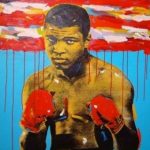 Does Sex Before An Athletic Event Really Hinder Performance?
Does Sex Before An Athletic Event Really Hinder Performance?
Good question! There are two schools of thought on this particular issue, but the short answer is that it could psychologically (although no study has definitively proven it), and “no” physically (unless you need a reduction in testosterone to help with excessive anxiety and lack of focus). That being said, there has never been any scientific study that shows that having sex before physical activity will decrease your performance. Most medical professionals state this myth is merely superstition caused by undereducated coaches. The idea that sex before an event causes a decrease in performance stems from a popular belief in professional boxing circles and in certain other sports in the 1950s and 60s. The Mexican Olympic team believed so much in the theory that they gave Potassium Nitrate to their athletes in hopes of preventing erections. The thought process… (more)
Although it’s difficult to find written accounts, it appears that people have been propelling themselves through the air with poles since ancient times. In fact, depictions of people leaping with poles can be found as far back as 400 BC. A practical and inexpensive way to traverse swampy marshy areas, propelling over wet places on poles has traditionally been a common practice in the fens of Cambridgeshire, Lincolnshire, Norfolk and Huntingdonshire, UK, as well as the marshes of the Netherlands. As the bogs and estuaries were drained and developed, it became custom for residents to keep jumping poles for use while walking around outside. Not restricted to the… (more)
| Share the Knowledge! |
|


